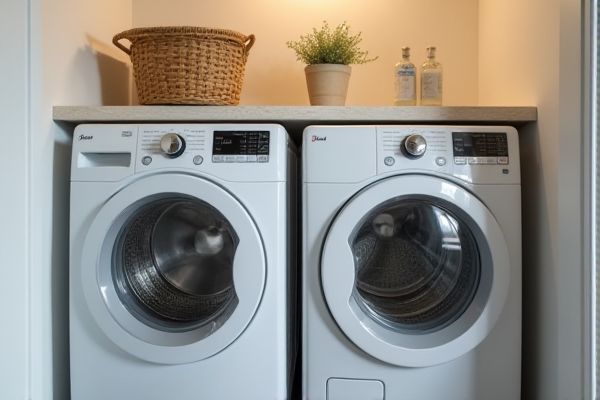
Front load washers offer superior energy efficiency and gentler fabric care compared to top load washers, which tend to have faster cycle times and easier access but may use more water. Discover the key differences and which type suits Your laundry needs by reading the rest of the article.
Table of Comparison
| Feature | Front Load Washer | Top Load Washer |
|---|---|---|
| Loading Style | Front loading door | Top loading lid |
| Water Efficiency | Uses less water, eco-friendly | Uses more water, less efficient |
| Energy Consumption | Lower energy usage | Higher energy usage |
| Cleaning Performance | Better at removing tough stains | Good, but less effective on heavy stains |
| Spin Speed | Higher RPM for faster drying | Lower RPM, longer drying times |
| Cycle Duration | Longer wash cycles | Shorter wash cycles |
| Space Efficiency | Stackable, saves floor space | Usually occupies more space |
| Maintenance | Requires regular gasket cleaning | Less maintenance-intensive |
| Price | Generally more expensive | Usually more affordable |
| Laundry Load | Best for large, bulky items | Good for small to medium loads |
Introduction to Front Load and Top Load Washers
Front load washers feature a horizontal drum design that uses gravity for effective cleaning and energy efficiency, making them ideal for saving water and electricity. Top load washers typically have a vertical drum and offer faster cycle times, convenient loading, and often lower upfront costs. Both types vary in capacity, washing performance, and maintenance requirements, influencing user preference based on household needs.
Design and Structure Differences
Front load washers feature a horizontal drum accessible through a door on the front, making them ideal for stacking and saving space in smaller laundry areas. Top load washers have a vertical drum with a lid on the top, allowing you to add clothes mid-cycle and often providing faster wash cycles. The structural design of front load washers typically promotes more efficient water and energy usage, while top load models offer easier access and less bending during loading and unloading.
Cleaning Performance Comparison
Front load washers deliver superior cleaning performance by utilizing a tumbling action that gently lifts and removes dirt from fabrics, often resulting in better stain removal and less wear on clothes compared to top load washers. Top load washers, while generally faster, rely on agitators or impellers that can be harsher on garments and less efficient at cleaning heavily soiled items. Your choice should consider the cleaning efficiency of front load models if optimal stain removal and fabric care are priorities.
Water and Energy Efficiency
Front load washers use significantly less water and energy compared to top load washers, consuming up to 40% less water per cycle and 25-30% less electricity. Their horizontal drum design enables faster spin speeds, extracting more water and reducing drying time, which further conserves energy. Top load washers typically use more water due to their vertical drum design and lower spin speeds, resulting in higher overall water and energy consumption.
Spin Speed and Drying Results
Front load washers typically offer higher spin speeds ranging from 1000 to 1600 RPM, resulting in more efficient water extraction and significantly shorter drying times. Top load washers generally have lower spin speeds, around 700 to 900 RPM, which can leave more moisture in clothes, leading to longer drying cycles. Choosing a front load washer improves your drying results by reducing residual water content, saving energy and time during the drying process.
Ease of Use and Accessibility
Front load washers offer greater ease of use and accessibility with a door located at the front, making it simple to load and unload without bending over, which is ideal for those with mobility issues. Top load washers require lifting the lid and reaching into the machine, which can be challenging for users with limited strength or flexibility. Your choice depends on prioritizing ergonomic design and physical accessibility for more comfortable laundry experiences.
Noise and Vibration Levels
Front load washers typically produce lower noise and vibration levels due to their horizontal drum orientation and advanced suspension systems, making them ideal for apartments or shared spaces. Top load washers often generate more noise and vibrations because of their vertical drum movement, although modern models have improved shock absorption technology. Choosing a front load washer can reduce household noise and minimize floor vibrations, enhancing overall laundry room tranquility.
Maintenance and Durability
Front load washers generally require less water and detergent, reducing the risk of residue buildup that can cause odors and mold, while top load washers are simpler to maintain with fewer seals and gaskets prone to wear. High-efficiency front load washers feature advanced components like a direct drive motor that enhances durability but may lead to higher repair costs compared to the mechanically simpler top load models. Proper maintenance for front load washers includes regular gasket cleaning and door left ajar to prevent mildew, whereas top load washers typically demand less frequent internal cleaning but may experience faster agitator wear over time.
Price and Value Considerations
Front load washers typically have a higher upfront cost but offer greater energy and water efficiency, resulting in long-term savings on utility bills. Top load washers are generally more affordable initially and may have lower repair costs, making them a budget-friendly option for many households. When evaluating your purchase, consider both the initial price and the potential value from reduced operating expenses over time.
Final Verdict: Which Washer Suits You Best?
Front load washers offer superior energy efficiency, better cleaning performance, and gentler fabric care, making them ideal for households focused on long-term savings and delicate laundry. Top load washers provide faster wash cycles, easier loading and unloading, and typically lower upfront costs, suiting busy families or those with limited bending mobility. Choosing the best washer depends on balancing priorities such as budget, space, laundry volume, and preferred features like water usage and cycle variety.
 homyna.com
homyna.com